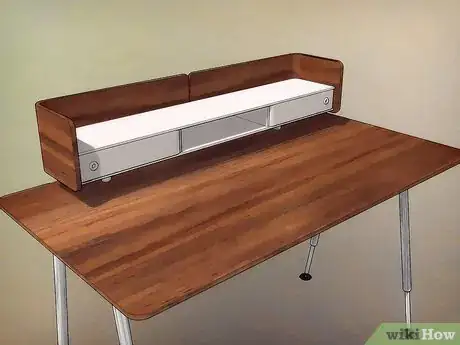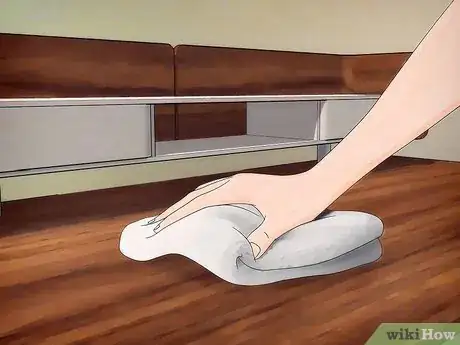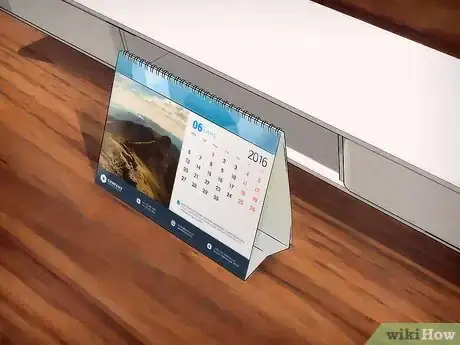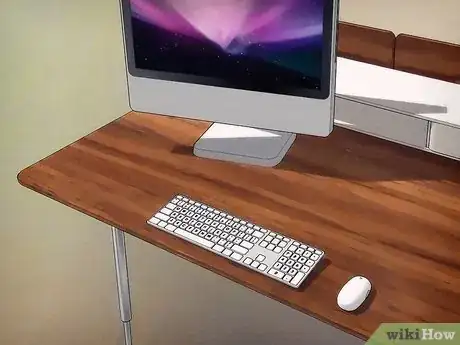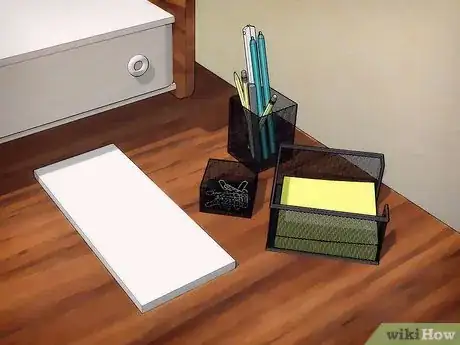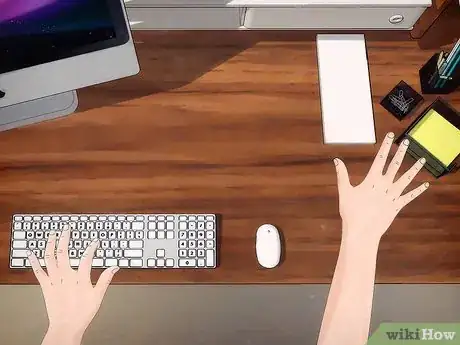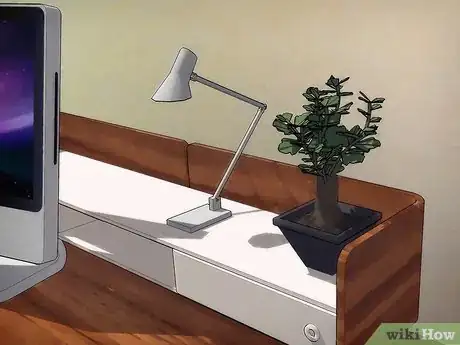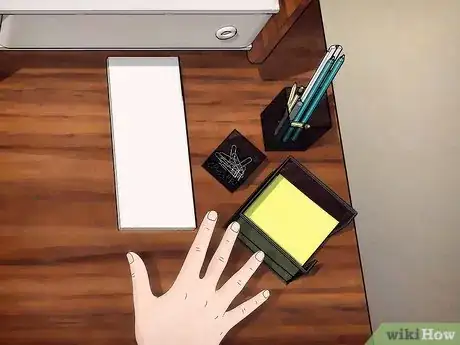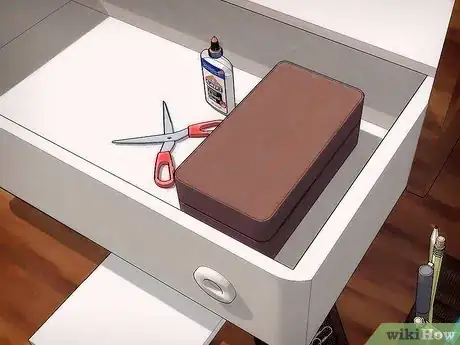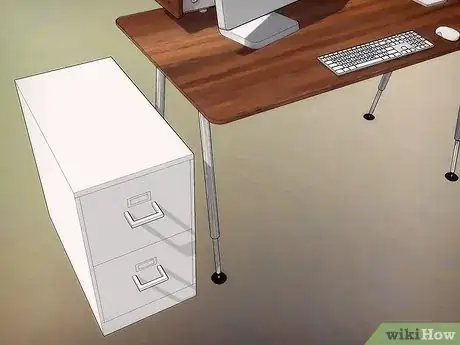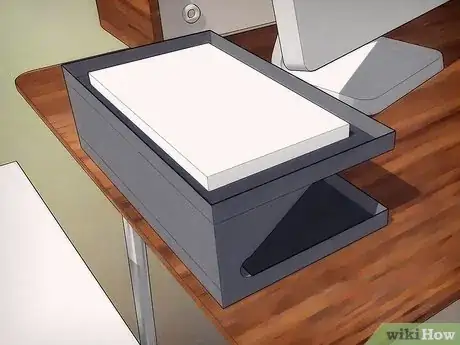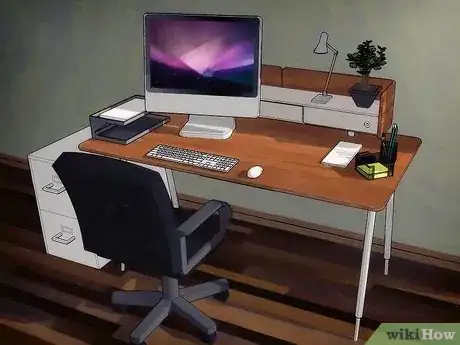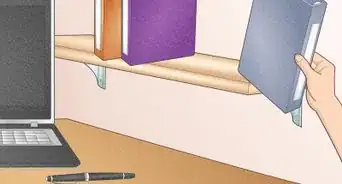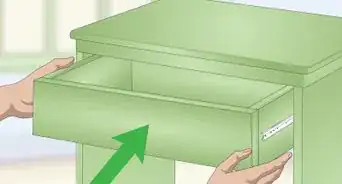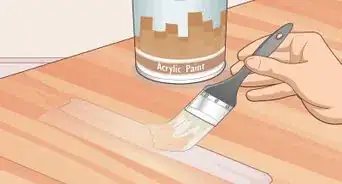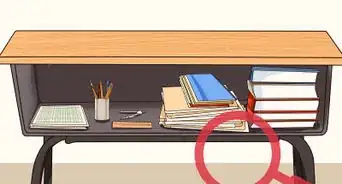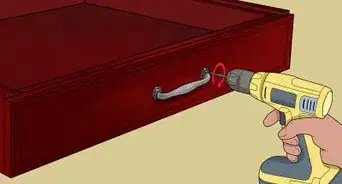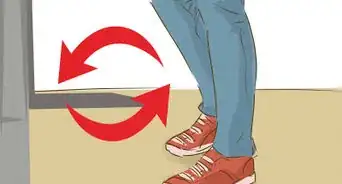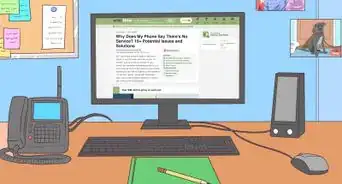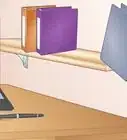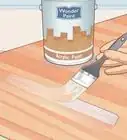This article was co-authored by Christel Ferguson. Christel Ferguson is the owner of Space to Love, a decluttering and organization service. Christel is certified in Advanced Feng Shui for Architecture, Interior Design & Landscape and has been a member of the Los Angeles chapter of the National Association of Productivity & Organizing Professionals (NAPO) for over five years.
There are 9 references cited in this article, which can be found at the bottom of the page.
wikiHow marks an article as reader-approved once it receives enough positive feedback. This article received 31 testimonials and 90% of readers who voted found it helpful, earning it our reader-approved status.
This article has been viewed 650,766 times.
As the saying goes, “a cluttered desk is a sign of a cluttered mind.” Keeping your workspace clean and organized can have a huge effect on your productivity, concentration, and ability to find everything you need. You might be surprised how much more efficiently you’ll be able to work after cleaning out a junked up desk. All you need is a little bit of time, the discipline to throw away unneeded items, and a system for making sure everything is in its proper place.
Steps
Clearing Your Desk
-
1Start from scratch. Reorganizing will be easiest if you start with a blank desk. Clear everything off the top. Remove items from the drawers (if you have them). Keep everything together on a separate table or on the floor so you can go through it later. Once the initial clutter is out of the way, you’ll be able to assess exactly how you want your desk to look.[1]
- It will likely take much longer to go through your desk one object at a time looking for things to throw away.
-
2Clean your desk inside and out. Take advantage of your desk being clear and use the opportunity to give it a good cleaning. Dust and wipe your desktop down with a multi-surface cleaner. Treat lingering stains and polish away scratches in wooden desks. Your desk will look brand new when you’re finished.
- Be sure everything has been removed from the desk before you start cleaning. Otherwise, you’ll have to clean around the existing clutter.
Advertisement -
3Throw away old and unnecessary items. Take the junk you removed from your desk and divide everything into two piles: one for things to throw away, and another for things you intend to keep. Be stern with your choices. Get rid of as many unimportant items as you can until your stuff has been pared down to the bare necessities. This will make it easier to keep up with everything.[2]
- People often develop attachments to things they don’t use that have no benefit to them. Letting go of unused belongings can bring you some much-needed peace of mind once it’s done.
- Don’t forget to dispose of any trash you find while clearing out your desk. This can account for a large portion of the clutter.[3]
-
4Update your space. Take a look around your desk for anything that’s no longer current. This can include outdated calendars, answered and unanswered mail and even old photos. Find fresh replacements for these objects. Throw away the out-of-date items or put them in storage. Everything on your desk should be new and ready to use going forward.
- It’s okay to hold onto things that have sentimental value. If you have an old picture, gift or memento you want to keep, stash it away somewhere safe and keep your desk free for its intended use.
Reordering Your Desk
-
1Change up your desk’s configuration. Now that it’s time to start putting things back on your desk, don’t just stick everything back where it was. Think of new ways you could reorder your desk to take advantage of the space you have. You might simply “mirror” your desk by putting things back on the opposite side, or choose new locations for each piece individually. Devising an engaging layout that will help you stay interested while you’re working.[4]
- Rearranging the items on your desk is a small tweak that will nonetheless help break up the monotony of always seeing the same things in the same places when you sit down to work.
- In China, there is an entire art devoted to changing the positioning of everyday objects. It is known as feng shui, and it has been shown to be very psychologically therapeutic.[5]
-
2Stock up on new supplies. Running low on paper, ink pens or staples? Visit an office supply store and pick up some materials to replenish your desk. Take a list with you so you won’t forget the basics or use your phone for the list. Focus on things that you use a lot and tend to go through quickly. When it’s time to get to work, you’ll be stocked on all the essentials that you need.[6]
- Even if your workplace provides office supplies, keeping a few of your own things on hand (such as a favorite type of pen) can make you feel more comfortable.
-
3Arrange items sensibly. Once you have an idea of how you want your new desk layout to look, position your belongings in a way that will maximize productivity while eliminating potential clutter. Reserve the center of the desk for your computer, for instance, while keeping important tools and documents within arm's reach. Not only will this make it easier to work, it will also keep you from having to search for things because they will always be in the most logical spot.[7]
- Your intuition will usually be your best guide for telling you where an item should go. If you instinctively look for a certain thing in a certain location, that’s probably the best place for it to go.
EXPERT TIPKathi Burns is a board certified Professional Organizer (CPO) and Founder of Organized and Energized!, her consulting business with a mission to empower people to master their environment and personal image by assisting them in taking control, making change and organizing their lives. Kathi has over 17 years of organizing experience and her work has been featured on Better Homes and Gardens, NBC News, Good Morning America, and Entrepreneur. She has a BS in Communication from Ohio University.Board Certified Professional Organizer
 Kathi Burns, CPO®
Kathi Burns, CPO®
Board Certified Professional OrganizerTo keep the items on your desk organized, make sure everything has a home or a designated place where it needs to stay and live. Group all your items together, sort and remove the duplicates, keep the things you need, and toss out the rest. At that point, you can put items in containers, label them, and then figure out where they're going to live based on the sizes of the items.
-
4Add some flair. A clean, organized desk is the goal, but that doesn’t mean it has to be dull. Add a few decorative touches to your desk to give it a little personality. A couple framed pictures, a small statue or a humorous coffee mug can liven up your space and make it feel more like home.[8]
- If you work in a cubicle or office, bring a few items from home to combat the drab atmosphere of the workplace.
- Tack up inspirational images and messages to keep you motivated to work hard.
Promoting Efficiency
-
1Keep your most essential items close at hand. If you find yourself reaching for certain things a lot, make sure they’re accessible. Give some thought to how frequently you reach for certain items on your desk and arrange them in order of importance. By taking this approach, you can streamline the process of finding and using various supplies.[9]
- Writing utensils, typing paper, notebooks, communication devices and digital accessories might all be kept out in the open, or somewhere else that you can get to easily.
- Separate pens and pencils into a cup to keep them together and ready to use without taking up too much space.
- Leave paper clips and staplers near the printer or wherever you complete paperwork.
- You can save as much as an hour a day by minimizing the time it takes you to hunt for things in a messy desk.
-
2Put frequently used items in easy-to-reach drawers. Non-essential supplies that see a lot of use can go in drawers so that you can take them out as they’re needed. Reserve the top drawers of your desk for larger items and things that you use often but don’t necessarily need to keep out on the desktop.[10]
- For instance, you might find that you use your laptop, tablet and other electronic devices more often than pen and paper for completing your work. In this case, these secondary materials can be stored away close at hand while leaving your desk clear for your electronics.
- If you have a lot of smaller items, buy some desk drawer organizer trays. These fit neatly into the drawers of your desk and are made up of compartmentalized sections that let you keep everything organized and visible in its proper place.
- Make a mental priority list of where things should go in your workspace. If you use an item frequently or it’s important to keep up with, leave it on your desktop. If you have a need for it every now and then, secure it in a nearby drawer. If you rarely use it or it doesn’t really belong on your desk, find someplace else to keep it.
-
3Store unused clutter out of the way. Anything you decide to keep but don’t need on hand at your desk should be stored elsewhere so that it doesn’t accumulate and turn into a mess. This includes personal items, snacks and beverages, and gadgets you only need on rare occasions. Written documents should go into folders and then into a filing cabinet, while other materials might need to be put away in a bottom drawer or closet if they’re not likely to be used. Keep as much off and out of your desk as you can, except for the things that you have to have.
- Try to get in the habit of putting away things after you’ve used them. Otherwise, they have a tendency to accumulate on your desktop or get stuffed into a drawer that can quickly fill up with junk.
-
4Use a letter tray to keep up with paperwork. To facilitate sorting paper documents, invest in a letter tray. These are shallow, multi-tiered containers that allow you to designate each level for incoming and outgoing paperwork, as well as answered and unanswered mail. By confining your written materials to a letter tray, folders and a filing cabinet, you’ll prevent your desk space from becoming overwhelmed by loose paper.[11]
- Using a paper tray, or multiple trays for different purposes, is a simple trick that can help eliminate the majority of paper clutter on your desk.
- Have one tray ready for finished/unfinished paperwork, another for incoming/outgoing mail, etc.[12]
-
5Get your shared work area under control. Some people might have to make use of a communal desk or partitioned cubicle while at the office, or your desk may just be in close proximity to others, leaving you with a limited amount of room. You can still take steps to tame a shared space.
- First, make sure there are clear boundaries in place to distinguish what belongs where. Then, you can begin organizing your own section to maximize order and efficiency.
- Label your personal materials and keep them close to where you sit. Identify which paperwork is yours and sort it into individual file folders, and from there into drawers or paper trays.
- Have a designated place for shared supplies so that extraneous clutter doesn't spill into your area.[13] [14]
- Carry a backpack or briefcase to help you keep tabs on your stuff. If you're working in a setting with shared space and storage, you might not be able to keep as many supplies and belongings on your desk or in nearby drawers.[15]
- Stay on top of regular sorting and cleaning to keep a shared desk or workspace from turning into a mess. More people concentrated into the same confined area means more trash, stray papers and general disarray.
Expert Q&A
-
QuestionHow do I maximize my desk space?
 Christel FergusonChristel Ferguson is the owner of Space to Love, a decluttering and organization service. Christel is certified in Advanced Feng Shui for Architecture, Interior Design & Landscape and has been a member of the Los Angeles chapter of the National Association of Productivity & Organizing Professionals (NAPO) for over five years.
Christel FergusonChristel Ferguson is the owner of Space to Love, a decluttering and organization service. Christel is certified in Advanced Feng Shui for Architecture, Interior Design & Landscape and has been a member of the Los Angeles chapter of the National Association of Productivity & Organizing Professionals (NAPO) for over five years.
Professional Organizer Organize your items and use space-saving storage options. Group the items you clean from your desk and decide what's worth keeping. Once you have all your pens together and all your scissors together, you might see that you have five scissors when you only need two. You can also tell what type of storage you need for what's left, like a large container for pens, and a smaller one for Post-it Notes.
Organize your items and use space-saving storage options. Group the items you clean from your desk and decide what's worth keeping. Once you have all your pens together and all your scissors together, you might see that you have five scissors when you only need two. You can also tell what type of storage you need for what's left, like a large container for pens, and a smaller one for Post-it Notes. -
QuestionHow do I keep my desk clean and organized?
 Christel FergusonChristel Ferguson is the owner of Space to Love, a decluttering and organization service. Christel is certified in Advanced Feng Shui for Architecture, Interior Design & Landscape and has been a member of the Los Angeles chapter of the National Association of Productivity & Organizing Professionals (NAPO) for over five years.
Christel FergusonChristel Ferguson is the owner of Space to Love, a decluttering and organization service. Christel is certified in Advanced Feng Shui for Architecture, Interior Design & Landscape and has been a member of the Los Angeles chapter of the National Association of Productivity & Organizing Professionals (NAPO) for over five years.
Professional Organizer When you're doing the initial clean, make sure everything has a home. Clear off the top of the desk and give everything a home in drawers or elsewhere. If you have an abundance of paperwork, put them in categories and organize them into folders in a filing cabinet off the desk. That way, you can just concentrate on putting things back where they belong.
When you're doing the initial clean, make sure everything has a home. Clear off the top of the desk and give everything a home in drawers or elsewhere. If you have an abundance of paperwork, put them in categories and organize them into folders in a filing cabinet off the desk. That way, you can just concentrate on putting things back where they belong. -
QuestionHow do I declutter my desk?
 Christel FergusonChristel Ferguson is the owner of Space to Love, a decluttering and organization service. Christel is certified in Advanced Feng Shui for Architecture, Interior Design & Landscape and has been a member of the Los Angeles chapter of the National Association of Productivity & Organizing Professionals (NAPO) for over five years.
Christel FergusonChristel Ferguson is the owner of Space to Love, a decluttering and organization service. Christel is certified in Advanced Feng Shui for Architecture, Interior Design & Landscape and has been a member of the Los Angeles chapter of the National Association of Productivity & Organizing Professionals (NAPO) for over five years.
Professional Organizer Utilize all the drawers and compartments in your desk. First, clear out your drawers and measure them. Then, decide what type of drawer organizers you want and size them to your drawer. Have a designated holder for your stapler with your staple remover, your scissors, your pens, etc. so your drawers end up neat and organized.
Utilize all the drawers and compartments in your desk. First, clear out your drawers and measure them. Then, decide what type of drawer organizers you want and size them to your drawer. Have a designated holder for your stapler with your staple remover, your scissors, your pens, etc. so your drawers end up neat and organized.
Warnings
- Make sure you remember where you put everything. If you have a lot of tools, gadgets, and files to keep track of, make a note of where everything in your desk is supposed to go to help you stay organized.⧼thumbs_response⧽
- A crowded workspace can stall productivity. Keep it simple and you'll work more efficiently.⧼thumbs_response⧽
References
- ↑ http://www.lifehack.org/articles/productivity/21-tips-to-organize-your-office-and-get-more-done.html
- ↑ https://timemanagementninja.com/2014/02/10-tips-to-keep-your-desk-clean-organized-productive/
- ↑ http://www.gq.com/story/how-to-clean-your-desk-
- ↑ http://www.lifehack.org/articles/productivity/21-tips-to-organize-your-office-and-get-more-done.html
- ↑ http://www.dummies.com/how-to/content/understanding-the-principles-of-feng-shui.html
- ↑ https://www.smead.com/Director.aspx?NodeId=1378
- ↑ http://money.cnn.com/2015/01/30/pf/jobs/desk-organized-tips/
- ↑ https://www.buzzfeed.com/jessicaprobus/make-your-cubicle-suck-less?utm_term=.cfqgMkr0Wn#.vuR7zAZdMN
- ↑ http://money.cnn.com/2015/01/30/pf/jobs/desk-organized-tips/
- ↑ http://www.lifehack.org/articles/productivity/21-tips-to-organize-your-office-and-get-more-done.html
- ↑ https://www.smead.com/Director.aspx?NodeId=1378
- ↑ http://www.lifehack.org/articles/productivity/21-tips-to-organize-your-office-and-get-more-done.html
- ↑ http://www.lifehack.org/articles/productivity/21-tips-to-organize-your-office-and-get-more-done.html
- ↑ https://www.youtube.com/watch?v=z6u5ESH3Rtw
- ↑ https://www.dailyworth.com/posts/4239-everything-you-need-to-carry-in-your-work-bag
About This Article
To organize your desk, start by clearing everything off the top of it and emptying all of the drawers. Then, go through everything and throw away whatever you don't need or want. Once you've done that, put your most essential items near the front of your desk so they're within reach when you need them. Next, put non-essential items that you still use regularly in easy-to-reach drawers. If you have a lot of paperwork, set up a letter tray on your desk so you can keep your papers organized. For more desk organizing tips, keep reading!
